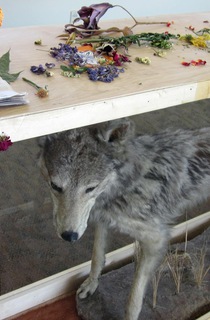Introducing ‘the Original’ Lobo Louie
We were looking for any signs of lobos, to see what we could learn about the critically endangered Mexican gray wolves, of which there are only 58 left alive outside of confinement.
People are talking once again, in the green mountains of New England about Gray wolf sightings: the animal of classical tales and my deepest imagination. Having just moved to Albuquerque from Vermont in 2009, one of the first things that grabbed my attention was a NMWA newsletter with the picture of a lobo on its cover and I thought, “What on earth is a Mexican wolf?” In no time at all I found myself walking through Gila Mountain lightning storms with Phil Carter and Sarah Rose, two local Mexican wolf advocates. We were looking for any signs of lobos, to see what we could learn about the critically endangered Mexican gray wolves, of which there are only 58 left alive outside of confinement.
The strength of the visual arts lies in its potential to communicate across cultures and in the ability of objects to physically illustrate as well as theoretically illuminate often hidden processes, connections and associated costs. At the University of New Mexico where students, faculty and alumni are collectively known as ‘lobos’, many shout, “everyone’s a lobo…woof, woof, woof “ at events and make little wolves with their fingers (Try this, it is pretty cool!) I have always made objects that attempted to examine the natural world in relation to human activity and culture, so last year my friend Sienna Wright and I began using chalk to draw images of lobo prints and wolves on the University of New Mexico campus walkways. We would go back to the same public places once or twice a week for months in a row, inviting others to join us, to re-draw the fading tracks along with messages like “Going Fast” and “UNM lobo=Mexican wolf.” This was an attempt to remind our community that iconic lobo-prints and cartoon mascots are not solely the corporate/cultural symbols of a university but intrinsically related to a critically endangered animal in the wild. I was visiting with Jon Dunnum at the Ceria Museum of Southwestern Biology when he unlocked a large wall storage locker and swung it open. There sat an entire taxidermied Mexican gray wolf of great age and visual impact. This wolf was definitely not looking good. However in viewing its physical body, something powerful and real was communicated.
We felt other people should see this rare animal so we put the lobo on display for a month in the Student Union Building at UNM in an exhibition called ‘Introducing ‘the Original’ Lobo Louie”. It was accompanied by artifacts, information and images, much of it gleaned from the archives of the Center for Southwest Research, detailing the history of the lobo at UNM. The first lobo was a real wolf captured in 1920 on Mt. Taylor and brought to UNM football games on a chain. Visitors saw images presented with school histories; transcripts from wolf trappers in the Gila Mountains hung alongside an actual steel leg-hold trap and a red and white uniform worn by the live wolf mascot. There were photos of UNM’s icon as it changed over the years from realistic wolf to the abstracted cartoon of today. A scientific poster from Ceria examined the status of the Mexican wolf in 2012.
We moved the wolf around the Student Union on a cart to UNM marching band music and held public events that included experimental music and readings in the company of the wolf. We alerted both the public and the media and invited Demis Foster to speak about her work with environmental campaigns. People went to see the wolf, wrote it notes and they even talked to it! Many people over the course of the exhibition connected with the natural lobo as part of their world for a time. The complex and diverse world that sustains us must continue to include living Mexican gray wolves. They are powerful symbols of cohesiveness and community that we can ignore and continue to abstract only at a great cost with too much value lost.
-Daniel Richmond, 2012
Impact & Value
An important symbolic meaning attributed to the wolf is that of a competitor with humans, and that image has been and continues to be exploited by various interests including sports teams. The University of New Mexico’s mascot of a Mexican Grey Wolf is one of the earliest of these examples, where in the 1920’s a trapped, live, chained wolf was paraded on the football field during games. Through collaboration with a wilderness wolf advocacy group and a biological specimen museum using a selection of historical and contemporary documents, temporary pubic artwork, and vintage taxidermied wolf, this site-specific work examines a nearly 100-year history of symbolism and mythology.
No comments yet. Why not add the first?
Showcase
Prepared By Andrea Polli on behalf of ISEA2012 Albuquerque: Machine Wilderness
Areas Covered
Acknowledgements & Credits
Contributors:
- Daniel Richmond, Artist
- John Dunnum, The Museum of Southwest Biology

← Back to work
0 Comments